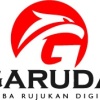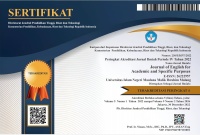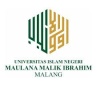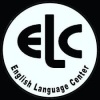PROMOTING LEARNERS’ AUTONOMY THROUGH VIDEO RECORDING IN PUBLIC SPEAKING CLASS
Abstract
Full Text:
PDFReferences
Al-Tamimi, N. O. (2014). Public Speaking Instruction: Abridge to Improve English Speaking Competence and Reducing Communication Apprehension. International Journal of Linguistics and Communication, 2(4). https://doi.org/10.15640/ijlc.v2n4a4
Alonazi, S. M. (2017). The Role of Teachers in Promoting Learner Autonomy in Secondary Schools in Saudi Arabia. English Language Teaching, 10(7), 183. https://doi.org/10.5539/elt.v10n7p183
Anas, I. (2019). Behind the scene: Student-created video as a meaning-making process to promote student active learning. Teaching English with Technology, 19(4), 37–56.
Bajrami, L., & Ismaili, M. (2016). The Role of Video Materials in EFL Classrooms. Procedia - Social and Behavioral Sciences, 232, 502–506. https://doi.org/10.1016/j.sbspro.2016.10.068
Borg, S., & Alshumaimeri, Y. (2019). Language learner autonomy in a tertiary context: Teachers’ beliefs and practices. Language Teaching Research, 23(1), 9–38. https://doi.org/10.1177/1362168817725759
Dang, T. T. (2012). Learner autonomy: A synthesis of theory and practice. The Internet Journal of Language Culture and Society, 35, 52–67.
El Mortaji, L. (2018). University Students’ Perceptions of Videotaping as a Teaching Tool in a Public Speaking Course. European Scientific Journal, ESJ, 14(8), 102. https://doi.org/10.19044/esj.2018.v14n8p102
Hanifa, R., & Yusra, S. R. (2018). Insight on Delivering Oral Presentation: Preparations, Problems, and Solutions. International Journal of Learning and Teaching, November, 318–325. https://doi.org/10.18178/ijlt.4.4.318-325
Juana. (2012). Psychological Factors That Hinder Students from Speaking in English Class ( A Case Study in a Senior High School in South. Journal of Education and Practice, 3(12), 100–110.
Kathleen M. Bailey. (2005). Practical English Language Teaching: Speaking. New York: McGraw-Hill ESL/ELT. http://www.amazon.com/dp/0073283169
Khoosf, S. G., & Khosravani, M. (2014). Introducing Email Portfolio as a Means of Developing EFL Learner’s Autonomy. Procedia - Social and Behavioral Sciences, 98, 504–512. https://doi.org/10.1016/j.sbspro.2014.03.446
Lengkanawati, N. S. (2017). Learner autonomy in the indonesian efl settings. Indonesian Journal of Applied Linguistics, 6(2), 222–231. https://doi.org/10.17509/ijal.v6i2.4847
Li, G., Sun, Z., & Jee, Y. (2019). The more technology the better? A comparison of teacher-student interaction in high and low technology use elementary EFL classrooms in China. System, 84, 24–40. https://doi.org/10.1016/j.system.2019.05.003
Littlewood, W. (1999). Defining and developing autonomy in East Asian contexts. Applied Linguistics, 20(1), 71–94. https://doi.org/10.1093/applin/20.1.71
Lynch and Orr. (2016). Using Group Roles to Promote Autonomy in the University Classroom. 2(2), 114–130.
Melvina, Lengkanawati, N. S., & Wirza, Y. (2021). The Use of Technology to Promote Learner Autonomy in Teaching English. Proceedings of the Thirteenth Conference on Applied Linguistics (CONAPLIN 2020), 546(Conaplin 2020), 315–321. https://doi.org/10.2991/assehr.k.210427.048
Menggo, S., Suastra, I. M., & Padmadewi, N. (2019). Self-Recording Videos to Improve Academic English-Speaking Competence. Asian EFL Journal, 25, 130–152.
Naqvi, S. (2015). Student created digital video and language learning: voices from omani classrooms. Third 21st CAF Conference at Harvard, in Boston, USA, 6(1), 246–259.
Nazara, S. (2011). Students’ Perception on EFL Speaking Skill Development. JET (Journal of English Teaching), 1(1), 28. https://doi.org/10.33541/jet.v1i1.50
Ottenbreit-Leftwich, A. T., Glazewski, K. D., Newby, T. J., & Ertmer, P. A. (2010). Teacher value beliefs associated with using technology: Addressing professional and student needs. Computers and Education, 55(3), 1321–1335. https://doi.org/10.1016/j.compedu.2010.06.002
Pendidikan, K., Teknologi, D. A. N., Pendidikan, K., & Teknologi, D. A. N. (n.d.). Kementerian pendidikan, kebudayaan, riset, dan teknologi. 99421834–99421836.
Phil Benson. (2011). Teaching and Researching Autonomy (Christopher N. Candlin (ed.); Second Edi). Routledge.
Ramadhiyah, S., & Lengkanawati, N. S. (2019). Exploring EFL learner autonomy in the 2013 Curriculum implementation. Indonesian Journal of Applied Linguistics, 9(1), 231–240. https://doi.org/10.17509/ijal.v9i1.15626
Richards, J. C. (2008). Teaching Listening and Speaking : From Theory to Practice. 1–37.
Shabani, M. (2013). The Effect of Background Knowledge on Speaking Ability of Iranian EFL Learners. International SAMANM Journal of Marketing and Management, 1(1), 25–33.
Shi, W., & Han, L. (2019). Promoting Learner Autonomy Through Cooperative Learning. English Language Teaching, 12(8), 30. https://doi.org/10.5539/elt.v12n8p30
Suharmanto. (2003). Learning Autonomy: A Way to Improve English Language Teaching (ELT) in Indonesia. TEFLIN Journal, 14(1), 111–122. https://doi.org/10.15639/teflinjournal.v14i1/111-122
Tokoz-Goktepe, F. (2014). Speaking Problems of 9 th Grade High School Turkish Learners of L2 English and Possible Reasons for those Problems: Exploring the Teachers and Students’ Perspectives. Procedia - Social and Behavioral Sciences, 116, 1875–1879. https://doi.org/10.1016/j.sbspro.2014.01.487
Tran, T. Q., & Duong, T. M. (2018). EFL learners’ perceptions of factors influencing learner autonomy development. Kasetsart Journal of Social Sciences, 41(1), 194–199. https://doi.org/10.1016/j.kjss.2018.02.009
Yee, K. M., Jafre, M., & Abidin, Z. (2014). The use of public speaking in motivating ESL learners to overcome speech anxiety. International Journal on Studies in English Language and Literature (IJSELL, 2(11), 127–135. www.arcjournals.org
Yuliani, Y., & Lengkanawati, N. S. (2017). PROJECT-BASED LEARNING IN PROMOTING LEARNER AUTONOMY. 7(2), 285–293.
DOI: https://doi.org/10.18860/jeasp.v5i1.16580
Refbacks
- There are currently no refbacks.

This work is licensed under a Creative Commons Attribution-ShareAlike 4.0 International License.






Editorial Office:
Pusat Pengembangan Bahasa
Program Khusus Pengembangan Bahasa Inggris (PKPBI)
Universitas Islam Negeri Maulana Malik Ibrahim Malang
Gedung C lantai 1
Jl. Gajayana No 50 Kota Malang, Jawa Timur, Indonesia
Kode Pos 65144, Telp/Fax : (0341) 570872
Email: jeasp@uin-malang.ac.id
JEASP : Journal of English for Academic and Specific Purposes is licensed under a Creative Commons Attribution-ShareAlike 4.0 International












